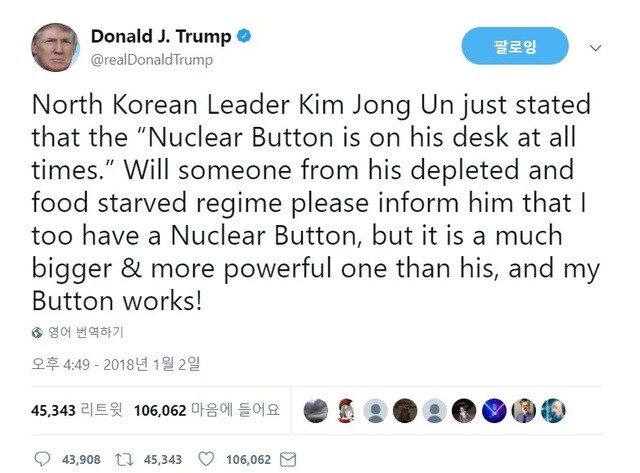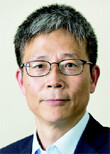hankyoreh
Links to other country sites 다른 나라 사이트 링크
[Correspondent’s Column] Past South Korean administrations bear portion of blame for failure of Obama’s “strategic patience”

During the administrations of Lee Myung-bak and Park Geun-hye, it was often said that the South Korea-US alliance was “watertight” and “ironclad.” South Korean government officials busied themselves with finding fancy adjectives to express the strength of the alliance. And whenever American government officials used such adjectives themselves, it was presented as a positive outcome for South Korea-US talks.
The South Korea-US alliance was indeed firm, at least in the sense that few conflicts were brought to the surface or made public. As Seoul and Washington maintained their North Korean policy of “strategic patience,” the North Korean nuclear issue got even worse, and it has now emerged as a direct security threat to the US. When US President Donald Trump declared that strategic patience had failed, the Lee and Park administrations must bear their share of the blame.
And that share, it turns out, may be quite large. The Obama administration showed its remorse for the unilateralism of the Bush administration by accepting nearly all its allies demands. In this way, the South Korean government basically ended up in the driver’s seat.
Thus it was that US State Department Special Representative for North Korea Policy Sung Kim’s attempt to visit North Korea at the end of 2014 was thwarted by staunch opposition from the Park administration. The Park administration also gave the US what amounted to unilateral notification about the closure of the Kaesong Industrial Complex in Feb. 2016. This shocked the Obama administration, which had put some stock in the Kaesong Complex, but the US went along with what its ally wanted. Putting the highest priority on preventing friction between allies resulted in a myopic policy toward North Korea and allowed the North to upgrade its nuclear capabilities.
The South Korean government’s response to Kim Jong-un’s New Year’s address has led some conservative experts in South Korea and the US to already begin expressing concerns about a rift in the alliance. They wonder whether the South Korean government is falling for North Korea’s scheme to drive a wedge between South Korea and the US.
First of all, their analysis frankly smacks of intellectual laziness. Since North Korea’s intentions have been the same for decades now, this ultimately leads to the conclusion that we should not engage in dialogue with the North. But what we really need right now is information about Kim Jong-un’s regime. If all we do is criticize North Korea’s “bad intentions,” we won’t be able to broaden the horizon of our understanding of North Korea by a single inch.
Second, there’s an imperious tone in the remarks of some experts who are worried about a rift between South Korea and the US. There’s tacit pressure from both American and South Korean experts to follow the US’s lead. These supposed concerns about division actually come across as an attempt to justify domestic division with the hope of undermining the Moon Jae-in administration. After all, “ironclad cooperation” doesn’t even exist among the 50 United States.
Third, even if North Korea’s intention is to drive a wedge between the US and the South, such efforts are to some extent present in all foreign policy, despite the word’s negative connotations. This is what is known as the “divide and rule” approach. Doesn’t Japan try to drive a wedge between South Korea and the US by claiming that the South is cozying up with China? Doesn’t the US warn against South Korea and China forming closer ties by urging the South not to kowtow to China? If we’re really sure that North Korea’s intention is to put daylight between South Korea and the US, then we should simply find a way to use that against them, instead of choking up before the fight has even begun.
In fact, the biggest potential source of conflict between the US and South Korea right now is the threat of withdrawing US troops from South Korea, which has been mentioned by some government officials and think tank experts in the US. The Trump administration’s overt exploitation of its ally South Korea’s greatest weakness in this way hints at the exercise of brute force comparable to China’s retaliation for the THAAD deployment.

Even so, and hard as this may be, it’s important for the Moon administration to maintain the appearance of doing its best to coordinate its position with the Trump administration. This is necessary to provide vindication for US experts who are sincerely helping the Moon administration, and domestically speaking, it’s also not bad as a defensive strategy for gaining political momentum. Along with taking the battle to the enemy, it’s time that we got ready to defend our own position, too.
By Yi Yong-in, Washington correspondent
Please direct questions or comments to [english@hani.co.kr]

Editorial・opinion
![[Editorial] Does Yoon think the Korean public is wrong? [Editorial] Does Yoon think the Korean public is wrong?](https://flexible.img.hani.co.kr/flexible/normal/500/300/imgdb/original/2024/0417/8517133419684774.jpg) [Editorial] Does Yoon think the Korean public is wrong?
[Editorial] Does Yoon think the Korean public is wrong?![[Editorial] As it bolsters its alliance with US, Japan must be accountable for past [Editorial] As it bolsters its alliance with US, Japan must be accountable for past](https://flexible.img.hani.co.kr/flexible/normal/500/300/imgdb/original/2024/0417/6817133413968321.jpg) [Editorial] As it bolsters its alliance with US, Japan must be accountable for past
[Editorial] As it bolsters its alliance with US, Japan must be accountable for past- [Guest essay] Amending the Constitution is Yoon’s key to leaving office in public’s good graces
- [Editorial] 10 years on, lessons of Sewol tragedy must never be forgotten
- [Column] A death blow to Korea’s prosecutor politics
- [Correspondent’s column] The US and the end of Japanese pacifism
- [Guest essay] How Korea turned its trainee doctors into monsters
- [Guest essay] As someone who helped forge Seoul-Moscow ties, their status today troubles me
- [Editorial] Koreans sent a loud and clear message to Yoon
- [Column] In Korea’s midterm elections, it’s time for accountability
Most viewed articles
- 1[Column] The clock is ticking for Korea’s first lady
- 2Samsung barricades office as unionized workers strike for better conditions
- 3[Editorial] When the choice is kids or career, Korea will never overcome birth rate woes
- 4[News analysis] After elections, prosecutorial reform will likely make legislative agenda
- 5S. Korea, Japan reaffirm commitment to strengthening trilateral ties with US
- 6Why Israel isn’t hitting Iran with immediate retaliation
- 7[Guest essay] How Korea turned its trainee doctors into monsters
- 8Japan officially says compensation of Korean forced laborers isn’t its responsibility
- 9[Editorial] Does Yoon think the Korean public is wrong?
- 10[Editorial] 10 years on, lessons of Sewol tragedy must never be forgotten